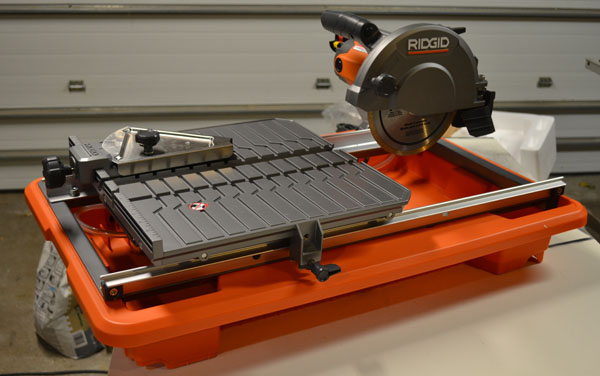RIDGID 7″ Tile Saw Review
RIDGID 7″ Tile Saw R4030
A couple months ago RIDGID introduced a new tile saw to the market with a lot of pro level features but without a pro level price. I don’t lay tile for a living but I do it enough that renting saws was becoming more trouble than it was worth. $60 a day for a pro level saw (with smaller cutting capacity) that was abused and well out of square. I was tired of it; it was costing me too much time and money to get a reasonable level of quality. I’ve put this saw through its paces and am pleased with how it worked.
Features and Specifications
- Input: 120V AC, 9 Amps
- No Load Speed: 6,500 r/min. (RPM)
- Cutting Wheel Diameter: 7 in.
- Rip Capacity: 24 in.
- Diagonal Capacity: 18 in.
- Max Depth of Cut: 2-1/4 in.
- Weight: 32 lbs.
- Die-Cast Aluminum Sliding Table
- Alignment Laser
- Deep Well Wave Wall Protects Submersible Pump From Debris
- Adjustable depth
- Bevels 0-45 degrees
- Backed by the RIDGID Lifetime Service Agreement, free parts, free service for life
Evaluation and Performance
When I first opened the box and saw all the parts I thought this saw was going to be a headache to use if not assembled exactly perfect. Thankfully everything is close to accurate out of the box and the major components are already assembled. I had to adjust the table guides slightly (1/8″ over 2′) but then it cut very square. Because of this I didn’t even bother with the laser. I think it’s an unnecessary feature if you set the saw up to cut square.
On a recent job I used 18×18 porcelain tiles and had no issues cutting them. Most were straight cuts but had a couple plunge cuts as well. I do wish there was an extension for the sliding table though. I had three tiles that needed just a 1/4″ trim and I had to keep constant pressure on just a small area of tile to keep it flat on the table without getting my fingers too close to the blade. It wasn’t a huge deal but a little extra support for the large tiles would help.
One feature I thought worked particularly well was the pump and water distribution pieces. The pump was isolated in its own section of the tub so that most of the debris was kept out. It delivered plenty of water to both sides of the blade out of two rubber “fingers”. I’ve used a few cheap saws in my day and have ended up soaked after a cutting session. This saw keeps the water mostly where it should. It could benefit from some splash guards to catch the spray out of the back of the saw and then on the side to catch water running off any large tiles. 12×12 and smaller tiles won’t have issues with water running off the tiles and missing the tub though. I’m not disappointed though, I was cutting outside and a little runoff posed no consequence.
I was pleased with the power of the saw. I wasn’t being gentle on the saw and was at times pushing the porcelain with excess pressure. The motor slowed ever so slightly but the cut continued at relatively the same rate.
Improvements
- Side extension for the sliding table
- Lose the laser
- Additional set of guide wheels on the sliding table for rip cutting 24″ tiles – the table would wobble about an 1/8″ side to side when it was pulled all the way back to accommodate a 24″ tile. An additional set of guide wheels in the front half of the table may prevent that.
- Rubberize the sliding table top
- Splash guards
Final Thoughts
I have to admit, I’m surprised the saw worked as well as it did. $300 isn’t a lot of money for a tile saw. There are a lot of saws with a similar list of features that go for more than double the price. It’s only going to take 5 days of tile cutting to break even. It’s a no brainer. Stop renting saws and pick this one up. Even if you’re a homeowner and you only have 2 or 3 tile projects in your future this saw is worth it.
Slideshow
Where To Buy
The RIDGID 7″ Tile Saw R4030 can be picked up for $297 at any Home Depot or online at the link below.
UPDATE
Home Depot has updated the listing and now includes a free stand. At under $300 this saw is such a great deal.
About the author
5 Comments
Leave a comment
Disclosure
Product reviews on this site contain our opinion of a product or service. We will always strive for objectivity and transparency in our reviews. Our goal is to provide readers with honest, objective information based on our own experiences. We never have and never will accept payment in exchange for a positive review. Many of the products that we review are provided to us for free by a manufacturer or retailer. In some cases, we also have advertising or affiliate relationships with manufacturers and retailers of products and services we review. For additional information please visit our additional disclosure policies.























Do you have any tips or know the best way to align the laser. I know it’s not necessary, but I would like to use it just as a reference. Thanks
Bernie,
I don’t have this laser (maybe Jeff will jump in on this) however, this is what I would do. I’d sit a tile or wood on the fence so that it just barely touches the blade as you move the blade from front to back. Basically you’re trying to establish where the blade would cut if it was running, then turn on the laser and adjust it to match that exact edge.
Good luck.
Bernie, as far as I can tell there is just a single screw holding the laser emitter in place. There are 4 little screws but those just hold the housing together.
This is the best picture I have of it and I wasn’t able to locate the manual online to reference the section for you.
https://plus.google.com/photos/113416329953220927803/albums/5796377044396953297/5796377724800579362?banner=pwa&pid=5796377724800579362&oid=113416329953220927803
Funny, I was doing the exact same thing this weekend with the saw (cutting 18″x18″ porcelain tiles), and have exactly the same comments. The saw cut very square, so I only briefly tried to alight the laser with the single set screw. However, after tinkering with it for about 5 min, I came to the same conclusion. It’s not needed, so I didn’t waste anymore time with it.
I also had the same issue of cutting ~1″ off the large tiles. Having a simple extension to hold the tile overhang would have been very useful. I noticed there is a 5/16″ (?) or so place where a bolt might be connected to the table to allow a DIY table extension, which I may try to add on.
Good review, I 100% agree with your assessment.
[…] step took quite awhile. I had to mark and cut every piece and fit them in one at a time. I used the RIDGID 7″ tile saw with a segmented blade. It cut very well and was very safe. The cuts are a great place to use up […]